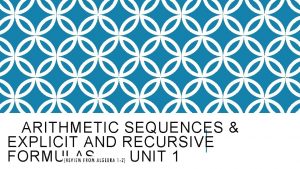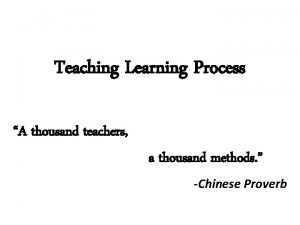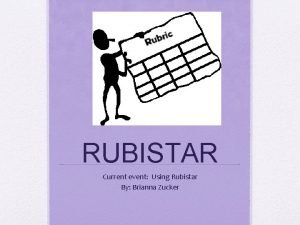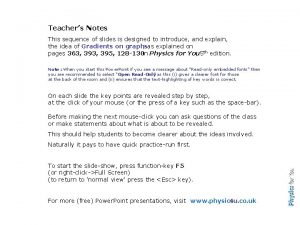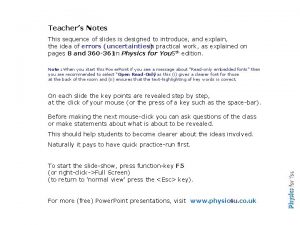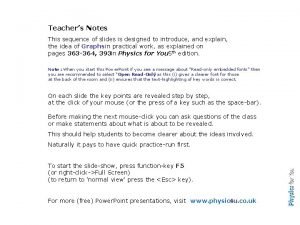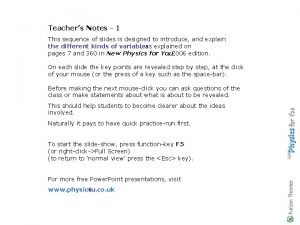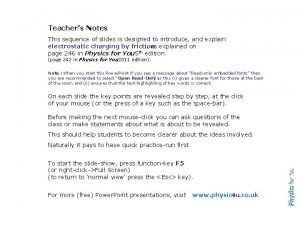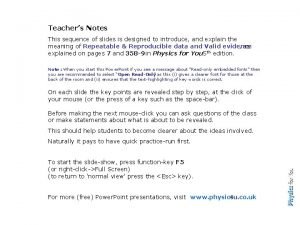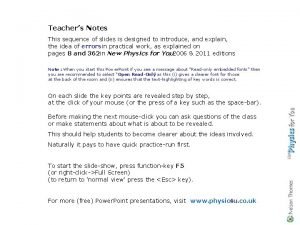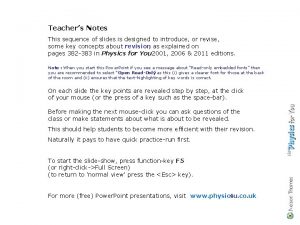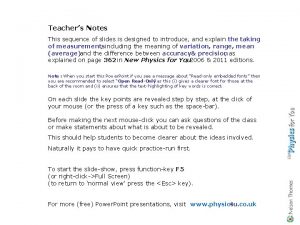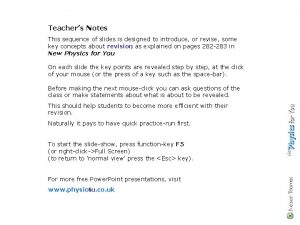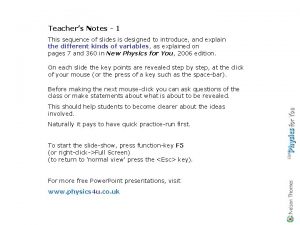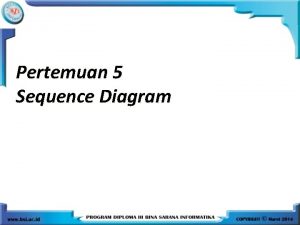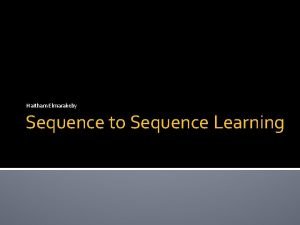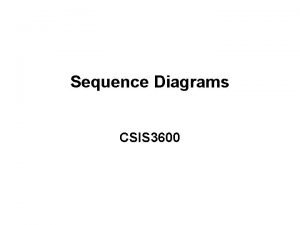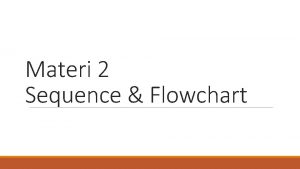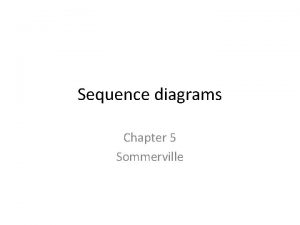Teachers Notes 1 This sequence of slides is
























- Slides: 24

Teacher’s Notes - 1 This sequence of slides is designed to introduce, and explain the different kinds of Variables , as explained on pages 7 and 362 in Physics for You , 5 th edition. Note : When you start this Power. Point if you see a message about “Read-only embedded fonts” then you are recommended to select “Open Read-Only ” as this (i) gives a clearer font for those at the back of the room and (ii) ensures that the text-highlighting of key words is correct. On each slide the key points are revealed step by step, at the click of your mouse (or the press of a key such as the space-bar). Before making the next mouse-click you can ask questions of the class or make statements about what is about to be revealed. This should help students to become clearer about the ideas involved. Naturally it pays to have quick practice-run first. To start the slide-show, press function-key F 5 (or right-click->Full Screen) (to return to ‘normal view’ press the <Esc> key). For more (free) Power. Point presentations, visit www. physics 4 u. co. uk

Teacher’s Notes - 2 In order to anticipate any awkward questions from students on this topic, it may be helpful to consider the following points, which arose out of a discussion on the Institute of Physics News. Group: --In Example 1 (stretching an elastic band) it shows the weight (independent variable) changing the elastic’s length (dependent variable). But you could just as easily say that you were changing the length of the elastic (independent) and then measuring how much weight was needed (dependent). --The simplest rule is to emphasise that the variable that YOU change is the independent (or input) variable. --Many students would find it easier to use the terms ‘input’ variable and ‘outcome’ variable, as these are more descriptive …but the UK exam specifications (and exam papers) do not use these terms. --In Example 3 (current in a circuit) the voltage is increased by adding more cells. You could say that the number of cells is the independent variable (assumes that the cells are identical). (This would be an example of a ‘discrete’ variable. )

Working Scientifically: Variables Physics for You, 5 th edition, pages 7 and 362

Learning Objectives You should learn : • About the different types of variables, • How to identify them when doing your practical work.

Variables are things that vary and change

Variables In any experiment there are 3 variables: § an § a independent § some control (or input) variable (or outcome) variables Let’s look at each type….

Independent (input) variable This is the thing that you decide to change. Example 1 Investigating how a weight affects the length of an elastic band. You decide the weight to apply, so: Weight is the independent variable.

Independent (input) variable This is the thing that you decide to change. Example 2 Investigating how the rate of cooling of a beaker depends on the initial temperature. You decide the initial temperature, so: initial temperature is the independent variable.

Independent (input) variable This is the thing that you decide to change. Example 3 Investigating how the current through a resistor depends on the voltage across it. Which is the independent variable as you add cells? The voltage is the independent variable.

Dependent (outcome) variable This is the variable that changes as a result. It is the variable that you measure. Example 1 Investigating how a weight affects the length of an elastic band. You measure the resulting length of the elastic band, so: Length is the dependent variable.

Dependent (outcome) variable This is the variable that changes as a result. It is the variable that you measure. Example 2 Investigating how the rate of cooling of a beaker depends on the initial temperature. You measure the temperature every minute as it cools, so: temperature is the dependent variable.

Dependent (outcome) variable This is the variable that changes as a result. It is the variable that you measure. Example 3 Investigating how the current through a resistor depends on the voltage across it. Which is the dependent variable here? The current is the dependent variable.

Control variables These are all the variables that must not change, to make sure it is a fair test. Example 1 Investigating how a weight affects the length of an elastic band. You must use the same elastic band all the time, and the same scale etc, so it is a fair test.

Control variables These are all the variables that must not change, to make sure it is a fair test. Example 2 Investigating how the rate of cooling of a beaker depends on the initial temperature. You must use the same beaker, with the same amount of water, in the same position in the room, at the same room temperature, so it is a fair test.

Control variables These are all the variables that must not change, to make sure it is a fair test. Example 3 Investigating how the current through a resistor depends on the voltage across it. Which are the control variables here? Use the same circuit at the same temperature each time.

Tables When you draw up a table of your results, the independent variable goes in the first column, like this: If you take several readings of the dependent variable, then you can calculate the mean (average) Then your results will be more accurate.

In Summary The independent variable is ? • weight The dependent variable is ? • length of the elastic The control variables are ? same elastic band, same scale, etc, so it is a fair test. Example 1

In Summary The independent variable is ? • initial temperature The dependent variable is ? • temperature as it cools The control variables are ? the same beaker, with the same amount of water, in the same position in the room, at the same room temperature, so it is a fair test. Example 2

In Summary Example 3 The independent variable is ? • voltage (p. d. ) The dependent variable is ? • current The control variables are ? the same circuit, at the same temperature each time, so it is a fair test.

Learning Outcomes You should now: • Understand the difference between - independent, - dependent, and - control variables • Be able to identify these variables when doing your practical work.

For more details, see: Ø Physics for You, 5 th edition, pages 7, 362 For more free Power. Points, visit Ø the web-site at www. physics 4 u. co. uk

If you are connected to the web at the moment, click below to see what’s available: http: //www. physics 4 u. co. uk/


 Kim kroll
Kim kroll A small child slides down the four frictionless slides
A small child slides down the four frictionless slides A crane lowers a girder into place at constant speed
A crane lowers a girder into place at constant speed Nucleotide to amino acid
Nucleotide to amino acid Repetition pseudocode
Repetition pseudocode Difference between infinite and finite sequence
Difference between infinite and finite sequence Convolutional sequence to sequence learning.
Convolutional sequence to sequence learning. Arithmetic explicit rule
Arithmetic explicit rule Cube wisc
Cube wisc I consider your behavior rude irresponsible and
I consider your behavior rude irresponsible and Ousedale school teachers
Ousedale school teachers Teachers in crisis contexts
Teachers in crisis contexts Stations of the cross for teachers
Stations of the cross for teachers Short term disability manitoba
Short term disability manitoba The good teachers poem
The good teachers poem A thousand teachers a thousand methods means
A thousand teachers a thousand methods means Teachers try science
Teachers try science Tci approach
Tci approach My polish teacher tie
My polish teacher tie Swot analysis example for teachers
Swot analysis example for teachers Rubistar 4 teachers
Rubistar 4 teachers Difference between rpms and ipcrf
Difference between rpms and ipcrf Four sided shapes
Four sided shapes Corporate grooming ppt
Corporate grooming ppt Planning assessing and reporting domain 5
Planning assessing and reporting domain 5







